Contents
- Amazing information
- Biological features
- Savoy cabbage varieties
- The composition and useful properties of the plant
- Growing and caring for savoy cabbage
- How cabbage is used in cooking
- Nutritional value of the product
- Among the valuable ingredients of the product:
- Let’s find out what medicinal properties this herbal product has:
- Restoration of the immune system.
- Decreased blood pressure.
- Harm
- Savoy cabbage rolls with mushrooms
- Products
- Bean soup with vegetables
Amazing information
Savoy cabbage is much sweeter than white cabbage, and in its nutritional qualities it is in many ways superior to its relative, this type of cabbage is especially useful for children and the elderly. It, like white cabbage, comes from wild species that grow on the shores of the Mediterranean Sea. It got its name from the name of the Italian county of Savoie, whose population has grown it since ancient times.
Today it is this type of cabbage that is widespread in Western Europe and the United States, occupying vast areas there. There it is eaten more than all other types of cabbage. And in Russia it is not widespread. There are several reasons for this – it is less productive, poorly stored and more demanding to care for.
It tastes like cauliflower. In cooking, savoy cabbage is considered the best cabbage for making stuffed cabbage and pies, it makes the most delicious cabbage soup and vegetarian soups, it is indispensable in summer salads. And any dish made from it is an order of magnitude tastier than the same, but made from white cabbage. It is quite obvious that Europeans and Americans were not mistaken when choosing the filling for their pies.
In addition to taste, it has one more advantage: its leaves are very delicate and do not have hard veins, like the leaves of a white-headed relative. The corrugated savoy cabbage leaves are intended for cabbage rolls, because It is convenient to lay the minced meat in the hollow of a raw sheet, and the sheet itself can be easily folded into an envelope or rolled into a tube. It is plastic without boiling and does not break. But for the traditional Russian pickling of cabbage, it is generally not suitable, because it lacks the crunchiness that is so necessary for this dish, like that of a white-headed sister.
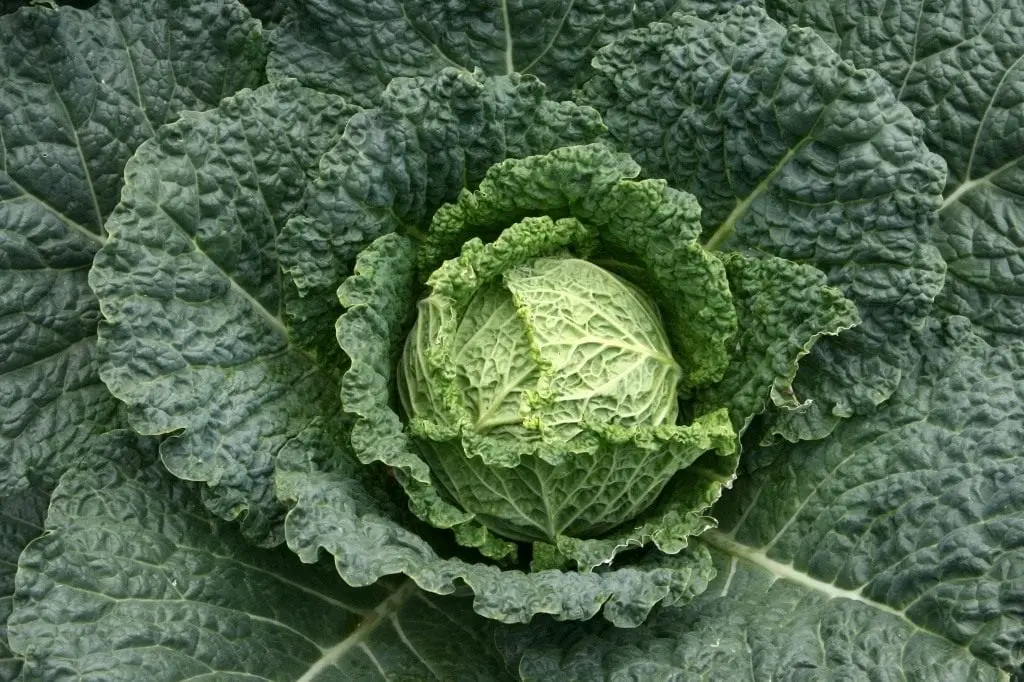
Possesses valuable nutritional and dietary properties. In terms of vitamin C content, it competes with potatoes, oranges, lemons, tangerines, and contains other vitamins. These substances play an important role in normal human nutrition, improve digestion, metabolism, cardiovascular activity and actively affect other processes. Savoy cabbage proteins and fiber are very easy to digest. That is why this product is included in the most gentle therapeutic diets and has a high value for the prevention and treatment of numerous gastrointestinal diseases.
Biological features
In appearance, savoy cabbage is similar to white cabbage. But her head of cabbage is much smaller, since it consists of thinner and more delicate leaves. Heads of cabbage have different shapes – from rounded to flat-rounded. Their weight ranges from 0.5 to 3 kg, they are much looser than that of white cabbage. Heads of cabbage have many cover leaves and are prone to cracking. It is also very important that they are less damaged by pests and diseases than the heads of cabbage.
Savoy cabbage leaves are large, strongly curly, wrinkled, bubbly, have a green color with different shades depending on the variety. The natural conditions of central Russia are well suited for growing this healthy vegetable. It is more hardy than other types of cabbage. Some late varieties of Savoy cabbage are especially cold-resistant.
Its seeds begin to germinate already at a temperature of +3 degrees. In the cotyledon phase, young plants withstand frosts down to -4 degrees, and the established hardened seedlings tolerate frosts down to -6 degrees. Adult plants of late-ripening varieties easily tolerate autumn frosts down to -12 degrees.
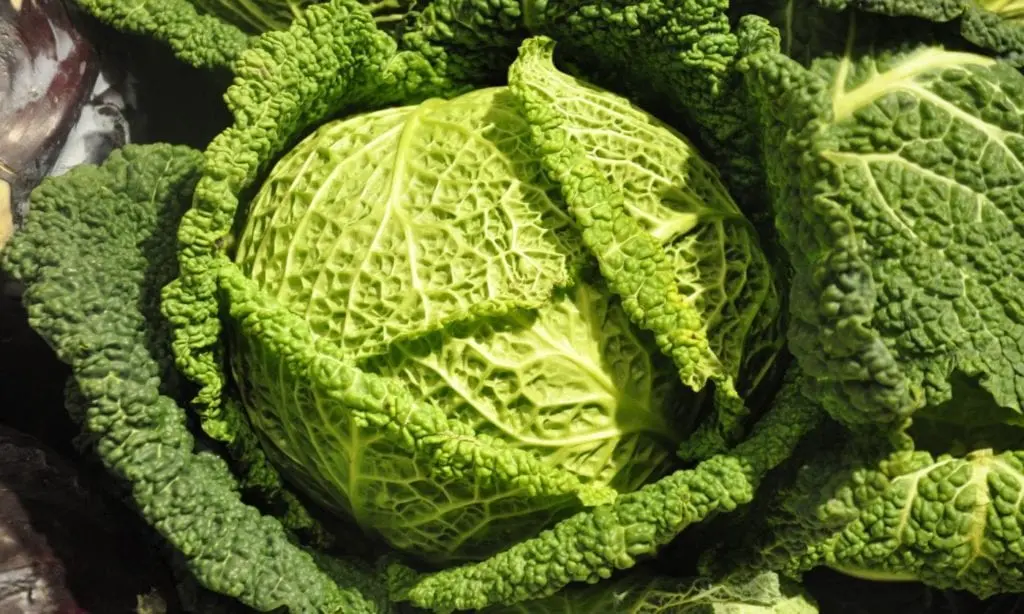
Savoy cabbage can be left in the snow later on. Before using, such cabbage must be dug out, cut off, and rinsed with cold water. At the same time, low temperatures have a beneficial effect on the taste of heads of cabbage, it retains all its medicinal properties.
Savoy cabbage is more drought-resistant than other types of cabbage, although at the same time it is demanding on moisture, because the evaporating surface of its leaves is very large. This plant is long day light, light-loving. Has significant resistance to leaf-eating pests.
It is demanding of high soil fertility and responsive to the application of organic and mineral fertilizers, and mid-ripening and late-ripening varieties are more demanding than early ripening ones.
Savoy cabbage varieties
Of the varieties of Savoy cabbage for growing in gardens, the following are worth noting:
- Alaska F1 is a late ripening hybrid. The leaves are strongly blistery, with a thick waxy coating. Heads of cabbage are dense, weighing up to 2 kg, excellent taste, suitable for long-term storage.
- Vienna early 1346 – early ripening variety. The leaves are dark green, strongly corrugated, with a weak waxy bloom. Heads of cabbage are dark green, round, of medium density, weighing up to 1 kg. The variety is highly cracking resistant.
- Vertus is a medium late variety. Heads of cabbage are large, weighing up to 3 kg, with a spicy taste. For winter consumption.
- Twirl 1340 is a mid-late fruitful variety. Leaves are gray-green, with a waxy bloom. Heads of cabbage are flat-rounded, weighing up to 2.5 kg, medium density, stored until mid-winter.
- Virosa F1 is a mid-late hybrid. Heads of cabbage of good taste, intended for winter storage.
- Gold early – early ripening variety. Heads of cabbage of medium density, weighing up to 0.8 kg. Excellent variety for fresh use, resistant to head cracking.
- Kozima F1 is a late-ripening fruitful hybrid. Heads of cabbage are medium in size, dense, weighing up to 1.7 kg, yellowish on the cut. Stores well in winter.
- Komparsa F1 is a very early maturing hybrid. Heads of cabbage are light green, of medium density, resistant to cracking.
- Chroma F1 is a mid-season hybrid. Heads of cabbage are dense, weighing up to 2 kg, green, with a small inner stalk, suitable for long-term storage. The taste is excellent.
- Melissa F1 is a mid-season hybrid. Heads of cabbage strongly corrugated, medium density, weighing up to 2.5-3 kg, excellent taste. Resistant to head cracking, well stored in winter.
- Mira F1 is a very early maturing hybrid. Heads of cabbage weighing up to 1.5 kg, do not crack, have excellent taste.
- Ovass F1 is a mid-late hybrid. Its leaves have a strong waxy coating and a large bubbly surface. Heads of cabbage are medium. Plants are resistant to unfavorable weather conditions, weakly affected by mucous and vascular bacteriosis and fusarium wilting.
- Savoy King F1 is a mid-season hybrid with a large rosette of light green leaves. Plants form large and dense heads of cabbage.
- Stylon F1 is a late ripening hybrid. Heads of cabbage are blue-greenish-gray, round, resistant to cracking and frost.
- Sphere F1 is a mid-season fruitful hybrid. Heads of cabbage weighing up to 2.5 kg with dark green covering leaves, medium density, on the cut – yellow, good taste.
- Julius F1 is an early ripe hybrid. Leaves are finely bubbly, heads of cabbage are round, of medium density, weighing up to 1.5 kg, transportable.

The composition and useful properties of the plant
Nutritionists say that savoy cabbage is much more nutritious and healthier than other cruciferous varieties. It contains a large number of vitamins C, A, E, B1, B2, B6, PP, macro and microelements, it also includes phytoncides, mustard oils, vegetable protein, starch and sugar.
Thanks to such a unique set of nutrients, the plant has a powerful antioxidant effect and helps in the treatment of many diseases, including diabetes mellitus, diseases of the cardiovascular system and the gastrointestinal tract.
In addition, it is well absorbed by the body, promotes weight loss, improves digestion and metabolism, and slows down the aging process of cells.
Growing and caring for savoy cabbage
Cultivation of Savoy cabbage is practically no different from the technology of growing white cabbage. First, you should take care of the preparation of the seedlings. To this end, seeds are sown in early or mid-March in seedling boxes with pre-prepared and fertilized soil.
In order for the cabbage to produce friendly shoots, the air temperature in the room with the seedlings should be within + 20 ° … + 25 ° C. In this case, the first green shoots will hatch after three days.
As soon as this has happened, it is advisable to harden the cabbage. For this, the temperature in the room where the seedlings are stored should be lowered to + 10 ° C.
With the appearance of the first true leaf on the seedlings, the plants dive (they are transplanted into pots for further growth and development).
The whole process from the beginning of sowing seeds to planting the sprouts in open ground takes about 45 days. At the same time, early varieties of Savoy cabbage are recommended to be planted in the ground at the end of May, and middle and later varieties in June.
Fortified seedlings at the time of transplantation into the soil should have 4-5 leaves. At the same time, early varieties can please with a good harvest in June.

How cabbage is used in cooking
Savoy cabbage is a sweet vegetable without bitterness. Good for salads. Due to its delicate texture, it does not require long heat treatment.
Sausages, meat and vegetable fillings are often wrapped in leaves. Perfect for savory pies, casseroles and soups. Suitable for pies, dumplings and cabbage rolls.
Nutritional value of the product
Savoy cabbage is of low nutritional value. There are only 28 kcal in 100 grams. Nutritionists recommend including this product in the diet for those people who seek to lose weight and normalize metabolism.
Among the valuable ingredients of the product:
- Vitamins (PP, A, E, C, B1, B2, B6).
- Microelements (potassium, magnesium, phosphorus, sodium).
- Carotene, thiamine, riboflavin.
- Amino acids.
- Mustard oil.
- Cellulose.
- Pectin compounds.
- Savoy cabbage benefits
Let’s find out what medicinal properties this herbal product has:
Prevention of oncological diseases. In 1957, scientists made a phenomenal discovery. They found the components of ascorbigen in the Savoy cabbage. When broken down in the stomach, this substance slows down the growth of cancerous tumors. To obtain valuable medicinal qualities, it is necessary to eat the leaves fresh.
Slowing down the aging process. The antioxidant glutathione helps neutralize free radicals. This allows you to maintain the smoothness and elasticity of the skin, vascular walls.
Restoration of the immune system.
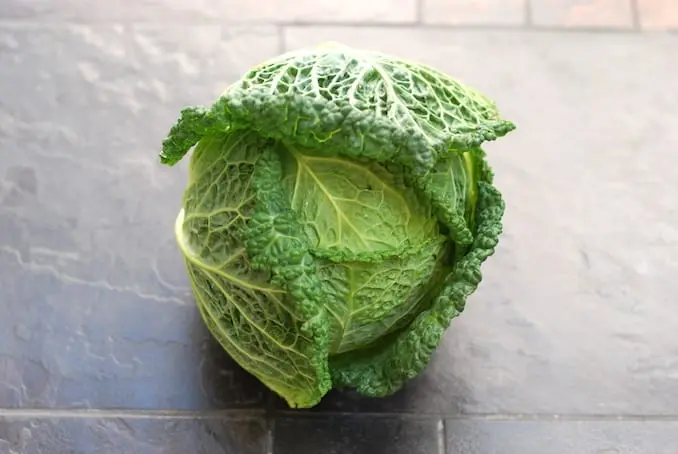
Normalization of the nervous system. The product helps to cope with stressful factors, to quickly experience traumatic situations. Regular intake of this green vegetable protects against depression and chronic fatigue.
Decreased blood sugar levels. Savoy cabbage contains a natural sweetener called mannitol alcohol. This unique substance is suitable for use in diabetes mellitus.
Decreased blood pressure.
Restoring digestive function. Cabbage contains a large amount of plant fibers, which are necessary for the activation of gastrointestinal peristalsis.
Prevention of diseases of the cardiovascular system. The product is recommended to be included in the menu of the elderly. This reduces the risk of heart attacks and strokes. Provides the prevention of cholesterol “plaques”.
Improves performance, memory and concentration. Helps to cope with fatigue.
It has a wound-healing effect. It has a positive effect on blood clotting.
Promotes weight loss. A diabetic vegetable activates metabolism, stimulates the consumption of subcutaneous fat reserves.
Harm
Savoy cabbage should not be eaten if you have an allergic reaction. Nutritionists warn against excessive consumption of a plant product for those people who:
- Gastritis, pancreatitis, enterocolitis, peptic ulcer have worsened.
- Problems with the gastrointestinal tract.
- Have had recent abdominal or chest surgery.
- There are severe diseases of the thyroid gland.
- The acidity of gastric juice is increased.
Savoy cabbage rolls with mushrooms
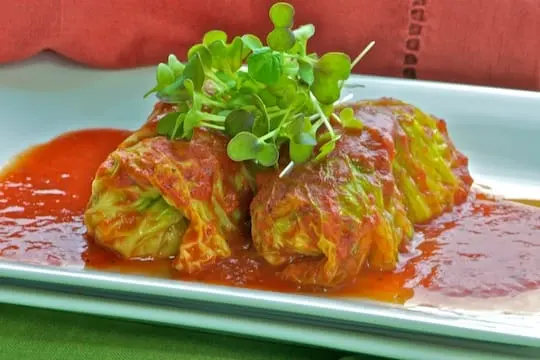
Savoy cabbage is tastier and more tender than white cabbage. And the stuffed cabbage rolls made from it are very tasty. In addition, they are stuffed with meat-rice-mushroom filling.
Products
- Savoy cabbage – 1 head of cabbage
- Boiled rice – 300 g
- Mixed minced meat – 300 g
- Mushroom caviar – 300 g
- Salt
- Ground black pepper
- To fill:
- Broth – 1 glass (can be diluted from a cube)
- Ketchup – 3 tbsp spoons
- Sour cream – 5 tbsp. spoons
- Margarine or butter – 100 g
Bean soup with vegetables
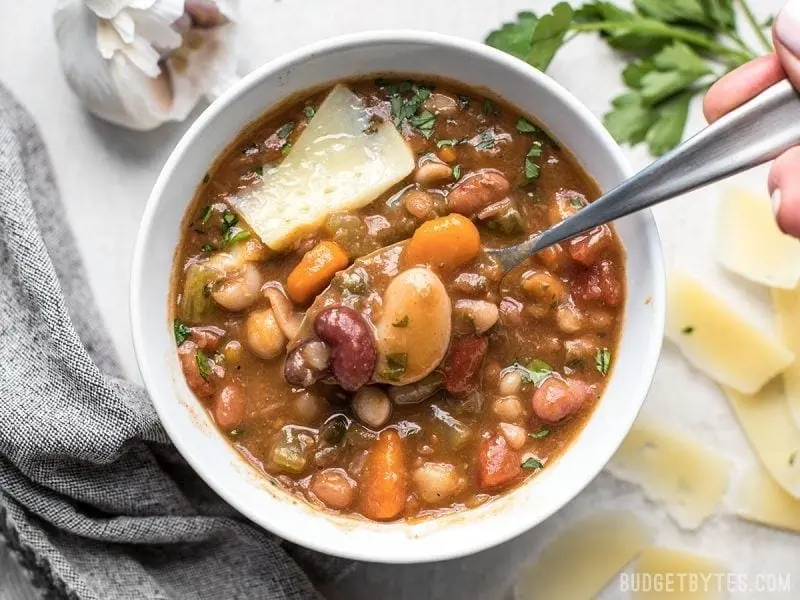
Food (for 6 servings)
- Dried white beans (soaked in water overnight) -150 g
- Dried light brown beans (soaked overnight) – 150 g
- Green beans (cut in pieces) – 230 g
- Chopped carrots – 2 pcs.
- Savoy cabbage (shredded) – 230 g
- Large potatoes (cut into pieces) – 1 pc. (230 g)
- Onions (chopped) – 1 pc.
- Vegetable broth – 1.2 l
- Salt to taste
- Ground black pepper – to taste
- *
- For the sauce:
- Garlic – 4 cloves
- Basil, large fresh leaves – 8 pcs.
- Olive oil – 6 tbsp. l.
- Parmesan cheese (shredded) – 4 tbsp l. (60 g)









